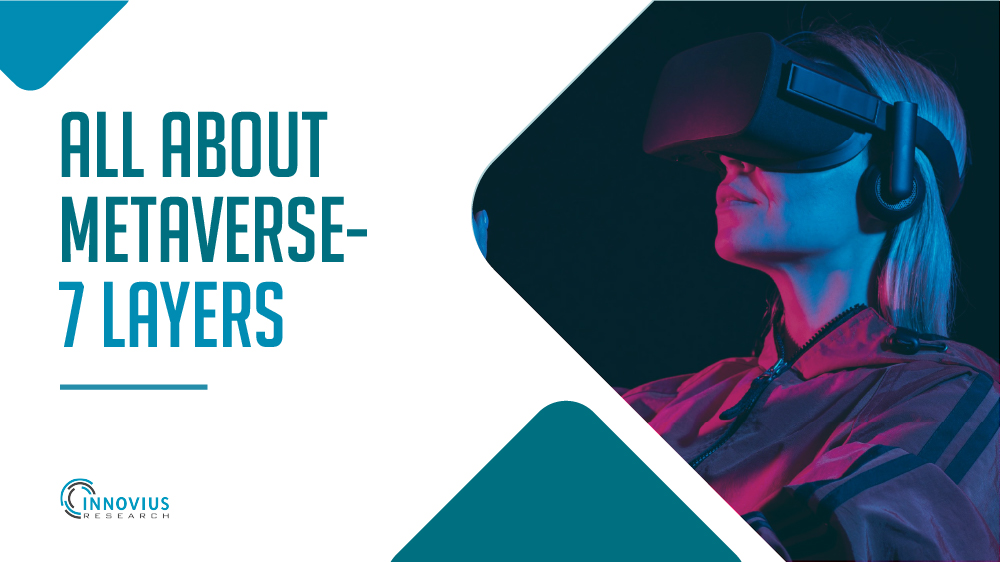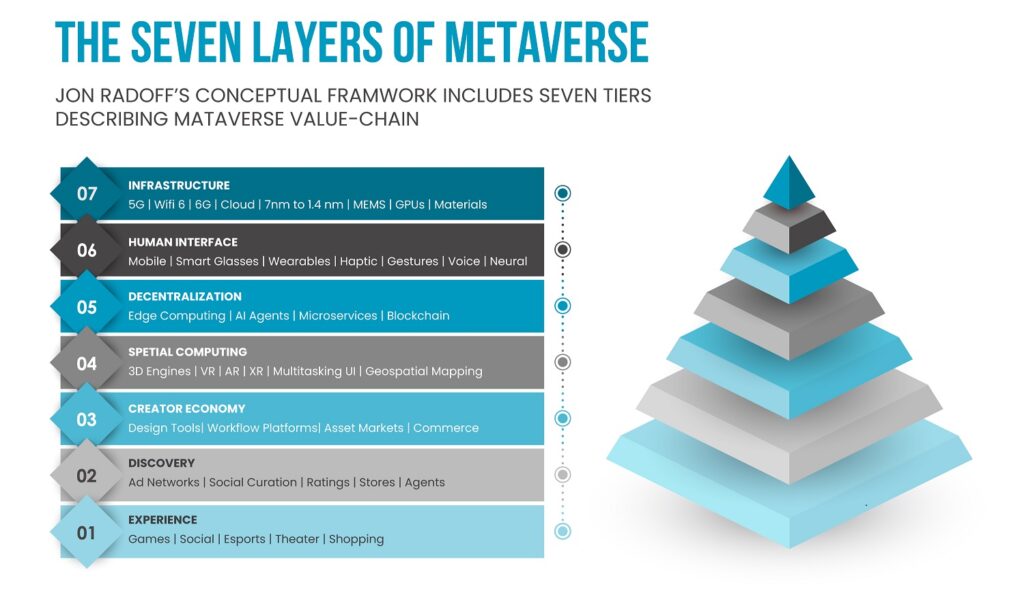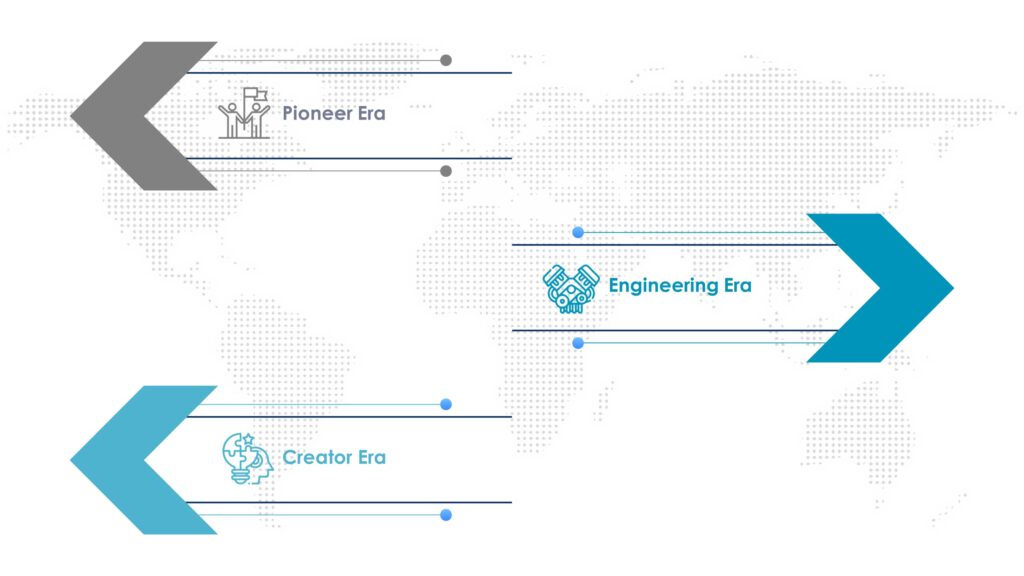
All about Metaverse – 7 Layers
What is Metaverse?
In the recent past, the phrase “Metaverse” has gained significant global attention. Although the term was first introduced by author Neal Stephenson in his 1992 sci-fi novel ‘Snow Crash’, it has recently turned into a popular buzzword in the world of technology, business, and finance.
“The metaverse is a 3D version of the Internet and computing at large. When these two technologies (internet and computing) first emerged, all interactions were primarily text-based (emails, messages, usernames, email addresses). Then they slowly became more media-based (photos, videos, livestreams). The next elevation of user interface and user experience is into 3D. Secondly, if we think of [a] mobile [phone] as placing a computer in our pocket and the internet being available at all times, think of the metaverse as always being within a computer and inside the internet.” – Mathew Ball, Venture Capitalist, and Angel Investor.
A metaverse is a network of 3D virtual worlds centered on social connection. It is characterized as a simulated digital environment that incorporates augmented reality (AR), virtual reality (VR), Internet of Things (IoT), 5G, artificial intelligence (AI), and blockchain, as well as social media principles, to build places for rich user interaction that resemble the real world. It is a self-contained virtual economy powered by digital currencies and non-fungible tokens (NFTs).
Metaverse is intended to provide permanent, decentralized, collaborative, and interoperable opportunities and business models that will allow companies to extend their digital operations.
“Metaverse will allow people to replicate or enhance their physical activities. This could happen by transporting or extending physical activities to a virtual world or by transforming the physical one. Although the goal of a Metaverse is to combine many of these activities, there are currently many individual Metaverses with limited functionality.” – Marty Resnick, VP Analyst at Gartner.
Layers of Metaverse (7 layers)

Jon Radoff is a business owner, novelist, and game creator, who has written extensively on the subject of “Building the Metaverse.” His conceptual framework is made up of seven layers that explain the metaverse market’s value chain.
Infrastructure is the foundation layer, which means that without a proper framework, no subsequent advances are feasible. As a result, technological processes are situated at the center of the layers of the metaverse.
Experience, discovery, creator economy, spatial computing, decentralization, and human interface comprises the other stages.
Layer 1 – Experience
This is the layer on which most businesses and individuals are now focused. Users interact in digitally-driven settings via content such as gaming, shopping, NFTs, e-sports, and theatre. The metaverse is more than just a 3D representation of reality. It will be the ultimate virtualization of physical space, products, and distance. The limits that are physically imposed will be lifted when physical space dematerializes.
As a result, the metaverse will give everyone a plethora of experiences that they are currently unable to enjoy. Various interactive live events (MILEs) presented on platforms such as Decentraland and Roblox demonstrate how the metaverse will make these events accessible to everyone.
Games will develop to include more live entertainment-inspired events, such as music concerts and immersive theatre, which have already appeared in Fortnite, Roblox, and Rec Room. Social entertainment will supplement e-sports and internet communities.
According to Jon Radoff, “More and more, consumers are also becoming content creators. Not just in the outdated sense of “user-generated content” but in the form of events and social interactions.”
Layer 2 – Discovery
The discovery layer is concerned with the push and pulls that introduces individuals to new experiences. “Pull” depicts an incoming system in which users actively seek information and experiences, while “push” is more outbound and incorporates procedures that notify users about what experiences await them in the metaverse. The discovery layer is, in reality, the most profitable for enterprises. Some ways in which inbound and outbound discoveries take place include:
⮞ Inbound: Community-driven content, Search engines, Real-time presence, App stores, and Earned media
⮞ Outbound: Display advertising, Emails and social media, and Notifications
Community-driven content is a considerably more cost-effective way of discovering new things than other types of marketing. As content becomes simpler to swap, trade, and share across more metaverse situations, it becomes a marketing asset. As a tool of discovery, content marketplaces will substitute application marketplaces.
Another major facilitator of inbound discovery is real-time presence. The discovery of metaverse experiences will not come just from content, but also from knowing what other individuals interested in the metaverse are doing right now. After all, the metaverse is all about inter-personal connections through shared experiences. Example – When a user logs into Steam, Battle.net, Spotify, Xbox, or PlayStation, they may see what their friends are playing. These gaming systems have employed real-time presence deftly to increase in-game involvement.
The metaverse has the potential to digitize social institutions and establish a decentralized identity ecosystem, shifting power away from a few monolithic entities and toward social groupings, allowing for the frictionless flow of knowledge and experiences. Display advertising, alerts, emails, and social media are the most successful outbound discovery channels. Metaverse experiences can also be discovered as a consequence of metaverse developers placing pertinent material in front of the public via outbound means.
Layer 3 – Creator Economy
According to Jon Radoff, “Creators gain tools, templates, and marketplaces of content that reorient development from a bottoms-up, code-centered process to a top-down, creatively centered process.” The creator economy refers to the technology that creators utilize to produce metaverse experiences, such as design tools and applications, as well as workflow platforms.
Content makers will be crucial in shaping this new environment. They have had remarkable success on social media platforms and will continue to be a significant driver of growth in the metaverse’s virtual reality. They will design their metaverse areas where their viewers may connect, hang out, and interact with them.
Creators will be able to transform the metaverse into a revenue-generating opportunity through selling commercial products, NFTs, and IRL products, displaying, and selling NFT collections.
Historically, creator economies evolved in predictable patterns, whether in the metaverse or games, the creation of websites, or even e-commerce:

⮞ Pioneer Era – The first people to create experiences for a specific technology lacked the necessary tools, they had to create all of their experiences from scratch. The first websites were written in HTML, users built their shopping carts for online retailers, and game creators wrote code directly to the graphic equipment.
⮞ Engineering Era – The initial market tools are intended to relieve overburdened engineers by providing SDKs and middleware to assist them in saving time.
Example – In games, graphics libraries such as OpenGL and DirectX were introduced to provide developers with the ability to produce 3D visuals with no low-level programming.
Ruby on Rails has made it easier for developers to create data-driven websites.
⮞ Creator Era – The number of creative is increasing at an alarming rate in this contemporary era. Creators are given tools, templates, and content marketplaces that shift development from a bottom-up, code-centered approach to an upward-facing, aesthetically driven process. 3D visuals can be made using game engines such as Unity and Unreal without needing to utilize the basic rendering of the visual interfaces of their studios utilizing visual interfaces inside their studios.
Example – At the moment, creators’ experiences in the metaverse are centered on centrally controlled platforms such as Roblox, Rec Room, and Manticore. In these platforms, a full set of integrated tools and discovery, social network, and monetization functions has created an unprecedented number of people to create experiences for other users.
Layer 4 – Spatial Computing
Spatial computing is a real/virtual combination that blurs the line between the actual and ideal worlds. Spatial computing has grown into a broad category of technology that allows to explore and alter 3D locations, as well as enrich the physical world with additional information and experience. This layer’s primary features include 3D engines such as Unity and Unreal.
Geospatial mapping with Cesium, Descartes Labs, and Niantic Planet-Scale AR also aids in mapping and analyzing the inner and outside worlds. Integration of data from devices (Internet of Things) and biometrics from humans is already widely employed in the health and fitness industries. Finally, speech and gesture recognition are integrated in spatial computing software.

Layer 5 – Decentralization
The metaverse, in an ideal world, would be decentralized, open, and diffused – governed by a single entity and belonging to no one and everyone at the same time. Experimentation and growth
increase when choices are maximized when systems are interoperable and built inside competitive marketplaces. Furthermore, creators get control over their own data and goods.
Decentralization includes the blockchain, smart contracts, open-source platforms, and, eventually, the prospect of self-sovereign digital identity. Distributed computing and microservices are increasingly enabling a scalable environment for developers to utilize online capabilities.
The most well-known example of a decentralized metaverse is Decentraland. It is a decentralized virtual environment that runs on the Ethereum blockchain and is governed by a Decentralized Autonomous Organization whose laws may be changed by voting. Individuals and companies are already acquiring land in the metaverse’s decentralized realms.
Layer 6 – Human Interface
Human interference is a critical feature of the metaverse’s hardware layer. Additionally, biosensors and neural connections between brains and computers are already being tested. The majority of the technologies involve wearables such as VR headsets and smart glasses, but it also contains neural network and haptics technology. This layer also includes haptics, which allows information to be sent by touch even when no objects are present. Using haptics, one may operate electronic gadgets in mid-air without touching buttons or a screen.
Layer 7 – Infrastructure
The seventh layer ‘infrastructure’ contains the technology that makes everything listed above a reality. 5G and 6G networks, Wi-Fi, cloud architecture, artificial intelligence, AR/VR/MR, blockchain, and graphics processing units are examples of the underlying technology and network components that enable the metaverse (GPUs). 5G networks will vastly boost capacity while simultaneously decreasing competition and latency.
Data Sources: Gartner, Zeebiz, Wired, Vice, Holonext, Business times, Leewayhertz, Itigic, Brisklogic, VRWorldtech, and others
Read more Market Reports and view Infographics.
Must Read

